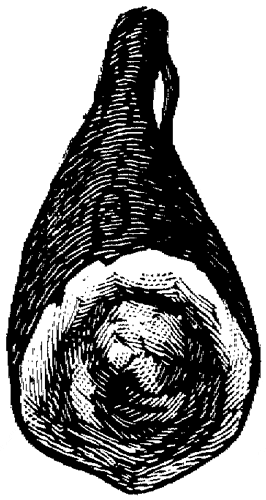Notes on curing ham from Christian Isobel Johnstone, two French interlopers, Theodora FitzGibbon, David Tanis and, well, us.
In her inimitable Cook and Housewife’s Manual ostensibly written by Meg Dods in 1826, a character from St Ronen’s Well by Sir Walter Scott, Christian Isobel Johnstone creates a parodic Anglo-Scottish world of high order. She also offers a lot of sound advice. Johnstone provides some of it in her own, or “Dods,’” voice but also presents it through the fictional characters she created to populate the equally fictitious Cleikum Club, a small gathering of absurd diners who do not much like or trust each other.

One of those characters, Sir Peregrine Touchwood, is based on another theft by Johnstone from the Well. Touchwood is a prolix and pedantic bore “whose eloquence for six long weeks fulminated over the Cleikum kitchen,” and “extended to such unreasonable compass, that a brief syllabus of the course is all we can give, without unduly swelling this Manual, and losing the purpose for which it was intended, namely, a PRACTICAL SYSTEM of RATIONAL COOKERY and DOMESTIC ECONOMY.” (Johnstone 34)
Some of the subjects headlined in that “syllabus of Culinary Lectures” are notable for their pomposity or absurdity. Demography dictates destiny when, for example, the legacy of the early spice trade requires assessment:
“Training of the palate of the cook--… Gentlemen of forty-five and upwards, generally found to require a double allowance of Cayenne, eschalot, garlic, salt, and flavoured wines or vinegars, compared with those under that age, unless the juniors have been bred at Oxford.--Bachelors to be allowed a fourth more seasoning than married men:--the same proportions hold between a military gentleman and a civilian.--For West and East Indians, peppers and all stimulating condiments may be used ad libitum. (Johnstone 36)
Johnstone provides no rationale for the delineation but the innuendo much of it reliant on stereotypes in common with the discipline of demographics, is apparent enough to inform her reader.
2. On choosing ham.
Other advice from the Syllabus remains sound almost two centuries later, including the instruction for assessing the quality of cured pork:
“Hams and Bacon good when the flesh adheres firmly to the bone, the smell fresh, the lean clear and not streaked with yellow.
Very good hams from Westmoreland, Yorkshire, and other parts of England:--if well fed and cured, quite equal to those of Bayonne and Westphalia.” (Johnstone 37-38)
3. On curing ham.
Johnstone herself describes four different ways to cure a ham; her own brine of salt, sugar and saltpeter seasoned with allspice, coriander seed and black pepper; and “M. Ude’s receipt” are the first two. Eustache Ude was the most renowned French chef of his time in London, an indication that notwithstanding her intersecting Scots and pan British cultural nationalism, Johnstone was not averse to the popular enthusiasms of her time, more a function of adroit marketing than any discrnable cosmopolitan culinary commitment. Ude omits all spice but does dump a bottle of vinegar, species unspecified, into the brine. As an endorsement, Johnstone cites another source: “‘This,’ says the venerable chef of Crockford’s, ‘is superior to a Westphalia ham.’” (Johnstone 495)
This, however, is Johnstone, and the prudent reader will hesitate to take anything she writes at face value. In fact the endorsement means next to nothing because, as her contemporaries should have known, the chef at Crockford’s was Ude himself. The story of Crockford’s and Crockford, a commoner who gambled his way to unimaginable wealth in a Regency age in which gambling was the greatest rage, is fascinating and substantial enough for another time.
Johnstone’s third cure belongs to another celebrated figure, a restauranteur rather than chef named Antoine Beauvilliers. A Frenchman so enthralled with English foodways that he called his restaurant, the first to open in Paris, La Grande Taverne des Londres, Beauvilliers may have been as canny an entrepreneur as Crockford in his own contrasting way. He capitalized not only on on the prerevolutionary French frenzy for English tavern culture but also on his subsequent fame by writing a bestselling cookbook covering both the French and English idioms for a crosschannel audience.
Beauviliers loads his appealing cure for ham with, Johnstone here, “all sorts of sweet herbs.” Then after a month in their brine Beauvilliers smokes his hams and rubs them “with wine and vinegar to keep off flies.” It was not, not yet, a squeamish age.

4. British cures for ham.
Finally Johnstone describes her “General easy receipt for curing hams or bacon of 14 lbs. weight, or in the proportion.” (Johnstone 495) It is for present purposes the best of the four, both in its adherence to traditional British foodways and for its adaptability to the domestic kitchen, with a little unexpected help from The New York Times. That adherence to tradition not only keeps the historical fire alight but also produces the more interesting ham.
The general easy receipt produces an interesting ham because it displaces the usual sugar with black treacle, whish lends the cure a lot more depth, flavor and depth of flavor. Theodora FitzGibbon goes an exemplary step further (as, it seems, usual) with A Taste of England by adding ale instead of the water everyone else uses to the treacle and other elements of her cure from Wiltshire:
“The salt brine made from 700g (1½ lb) salt has a little saltpetre added, also some juniper berries, 900g (2 lb) black treacle, peppercorns and 2.3 litres (2 quarts) beer all boiled. When the liquid is cool, the meat is added and left in for about 3 weeks. It must be turned daily and the pickle rubbed well in. Then it is dried before storing and soaked overnight before cooking.”
Fitzgibbon echoes Mrs Johnstone in specifying but “a little salptre.” As Johnstone notes with prescience in her Manual:
“Saltpetre dries up meat so much, that it is daily less and less employed. Much less of it will colour meat, or sausage meat, than is imagined…. ” (Johnstone 494)
These days saltpeter suffers a reputation tantamount to poison, but curing salt, or, another example of the insidious infiltration of French into the Anglophone kitchen, ‘sel rose,’ is more than an adequate alternative for pickling and meat and turning it pink instead of grey in the process.
5. To The Times…
And so to The Times, and to David Tanis, who not so long ago posted a recipe for “Miniature Home-Cured ‘Ham’” using pork tenderloin instead of a big leg. The radical reduction in scale is welcome innovation for the home cook who would like to experiment with pickling pork but who lacks an audience big enough to justify an investment in pounds and pounds of ham. She would, however, have better luck if she chose some shoulder--it need not be a lot--for the overlean tenderloin.
Notwithstanding an admirable riot, at least relative to the traditional cures other than Beauvilliers’, of seasoning including allspice, bay, clove, mustard seed, black peppercorns and dried thyme, The Tanis ‘ham’ emerges oddly inert in part because it is so lean, bereft as it is of much character hamwise other than its firm texture.
6. … and beyond, toward Pirates!
The cure for the problem is a different and longer cure than Tanis tried, a cure that incorporates that treacle and ale along with a little more time than his timid five days in the refrigerator, a location that it should go without saying (but there it is) slows the aging process in comparison to the traditional spot in the cellar or stillroom.
Follow our instructions in the practical to create a reasonable, inauthentic facsimile of an eighteenth century British ham. It may not turn out to be the Prize Ham adored and hoarded by the Pirate Captain Gideon Defoe conjures in The Pirates! In an Adventure with Scientists and then others, but it will be good ham.

